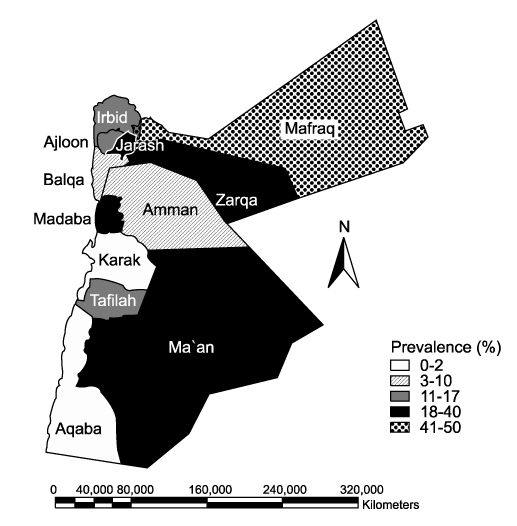J Vet Sci.
2009 Mar;10(1):61-65. 10.4142/jvs.2009.10.1.61.
Seroprevalence and risk factors for bovine brucellosis in Jordan
- Affiliations
-
- 1Department of Veterinary Clinical Sciences, Faculty of Veterinary Medicine, Jordan University of Science and Technology, P. O. Box 3030, Irbid 22110, Jordan. almajali@just.edu.jo
- 2Department of Basic Veterinary Medical Science, Faculty of Veterinary Medicine, Jordan University of Science and Technology, P. O. Box 3030, Irbid 22110, Jordan.
- KMID: 1089347
- DOI: http://doi.org/10.4142/jvs.2009.10.1.61
Abstract
- We investigated the seroprevalence and risk factors for Brucella seropositivity in cattle in Jordan. The sera from 671 cows were randomly collected from 62 herds. The antibodies against Brucella were detected using a Rose Bengal plate test and indirect ELISA. A structured questionnaire was used to collect information on the cattle herds' health and management. A multiple logistic regression model was constructed to identify the risk factors for Brucella seropositivity. The true prevalence of antibodies against Brucella in individual cows and cattle herds was 6.5% and 23%, respectively. The seroprevalence of brucellosis in cows older than 4 years of age was significantly higher than that in the younger cows. The seroprevalence of brucellosis in cows located in the Mafraq, Zarqa and Ma'an governorates was significantly higher than that of the other studied governorates. The multiple logistic regression model revealed that a larger herd size (odd ratio
= 1.3; 95% CI: 1.1, 2.6) and mixed farming (OR = 2.0; 95% CI: 1.7, 3.7) were risk factors for cattle seropositivity to Brucella antigens. On the other hand, the use of disinfectants (OR = 1.9; 95% CI: 1.1, 2.1) and the presence of adequate veterinary services (OR = 1.6; 95% CI: 1.2, 3.2) were identified as protective factors.
Keyword
MeSH Terms
Figure
Reference
-
1. Abbas B, Agab H. A review of camel brucellosis. Prev Vet Med. 2002. 55:47–56.
Article2. Al-Majali AM. Seroepidemiology of caprine brucellosis in Jordan. Small Rumin Res. 2005. 58:13–18.
Article3. Al-Majali AM, Majok A, Amarin N, Al-Rawashdeh O. Prevalence of, and risk factors for, brucellosis in Awassi sheep in Southern Jordan. Small Rumin Res. 2007. 73:300–303.
Article4. Al-Majali AM, Al-Qudah KM, Al-Tarazi YH, Al-Rawashdeh OF. Risk factors associated with camel brucellosis in Jordan. Trop Anim Health Prod. 2008. 40:193–200.
Article5. Al-Talafhah AH, Lafi SQ, Al-Tarazi Y. Epidemiology of ovine brucellosis in Awassi sheep in Northern Jordan. Prev Vet Med. 2003. 60:297–306.
Article6. Alton GG, Jones LM, Angus RD, Verger JM. Techniques for the Brucellosis Laboratory. 1988. Paris: Institute National de la Recherche Agronomique.7. Amin KMR, Rahman MB, Rahman MS, Han JC, Park JH, Chae JS. Prevalence of Brucella antibodies in sera of cows in Bangladesh. J Vet Sci. 2005. 6:223–226.
Article8. Botha CJ, Williamson CC. A serological survey of bovine brucellosis in four districts of Bophuthatswana. J S Afr Vet Assoc. 1989. 60:50.9. Crawford RP, Huber JD, Adams BS. Nielsen K, Duncan JR, editors. Epidemiology and surveillance. Animal Brucellosis. 1990. CRC Press: Boca Raton;131–151.10. Darwesh M, Benkirane A. Field investigations of brucellosis in cattle and small ruminants in Syria, 1990-1996. Rev Sci Tech. 2001. 20:769–775.
Article11. Luna-Martínez JE, Mejía-Terán C. Brucellosis in Mexico: current status and trends. Vet Microbiol. 2002. 90:19–30.
Article12. McDermott JJ, Arimi SM. Brucellosis in sub-Saharan Africa: epidemiology, control and impact. Vet Microbiol. 2002. 90:111–134.
Article13. Memish Z. Brucellosis control in Saudi Arabia: prospects and challenges. J Chemother. 2001. 13:Suppl 1. 11–17.
Article14. Muma JB, Samui KL, Siamudaala VM, Oloya J, Matope G, Omer MK, Munyeme M, Mubita C, Skjerve E. Prevalence of antibodies to Brucella spp. and individual risk factors of infection in traditional cattle, goats and sheep reared in livestock-wildlife interface areas of Zambia. Trop Anim Health Prod. 2006. 38:195–206.
Article15. Nicoletti P. The epidemiology of bovine brucellosis. Adv Vet Sci Comp Med. 1980. 24:69–98.16. Nielsen K. Diagnosis of brucellosis by serology. Vet Microbiol. 2002. 90:447–459.
Article17. Noordhuizen JP, Frankena K, van der Hoofd CM, Graat EAM. Application of Quantitative Methods in Veterinary Epidemiology. 1997. Wageningen: Wageningen Pers;76–77.18. Omer MK, Skjerve E, Holstad G, Woldehiwet Z, Macmillan AP. Prevalence of antibodies to Brucella spp. in cattle, sheep, goats, horses and camels in the State of Eritrea; influence of husbandry systems. Epidemiol Infect. 2000. 125:447–453.
Article19. Quinn PJ, Carter ME, Markey B, Carter GR. Clinical Veterinary Microbiology. 1994. London: Wolfe Publishing;261–267.20. Radostits OM, Gay CC, Blood DC, Hinchcliff KW. Veterinary Medicine: A Textbook of the Diseases of Cattle, Sheep, Pigs, Goats and Horses. 2000. 9th ed. London: Saunders;867–891.21. Refai M. Incidence and control of brucellosis in the Near East region. Vet Microbiol. 2002. 90:81–110.
Article22. Salman MD, Meyer ME. Epidemiology of bovine brucellosis in the Mexicali Valley, Mexico: literature review of disease-associated factors. Am J Vet Res. 1984. 45:1557–1560.23. Samartino LE. Brucellosis in Argentina. Vet Microbiol. 2002. 90:71–80.
Article24. Shareef JM. A review of serological investigations of brucellosis among farm animals and humans in northern provinces of Iraq (1974-2004). J Vet Med B Infect Dis Vet Public Health. 2006. 53:Suppl 1. 38–40.
Article25. Silva I, Dangolla A, Kulachelvy K. Seroepidemiology of Brucella abortus infection in bovids in Sri Lanka. Prev Vet Med. 2000. 46:51–59.
- Full Text Links
- Actions
-
Cited
- CITED
-
- Close
- Share
- Similar articles
-
- Seroprevalence of Brucellosis among Risk Population in Gyeongsangbuk-do, 2006
- Seroprevalence and Potential Risk Factors Associated with Neospora spp. Infection among Asymptomatic Horses in Jordan
- Brucellar Spondylodiscitis in an Endemic Bovine Brucellosis Region of Korea: A Case Report
- Seroprevalence and Risk Factors of Brucellosis among Slaughterhouse Workers in Korea
- Epidemiology of brucellosis among cattle in Korea from 2001 to 2011


